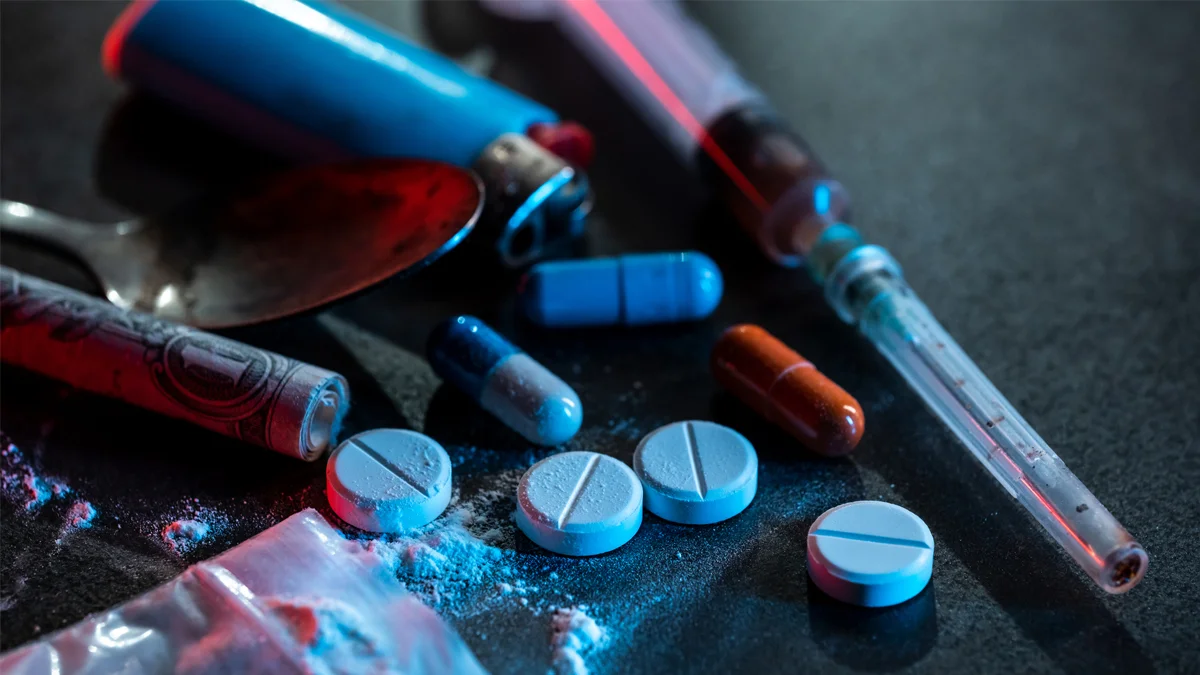
Understanding The Stages Of Addiction
Learn more about addiction, its stages, and discover the best treatment options with The Recovery Team.

Substance abuse remains a demanding concern in the United States, impacting individuals, families, and communities nationwide. From prescription medications found in medicine cabinets to illicit drugs sold on the streets, the spectrum of abused substances is broad.
In this article, we will delve into some of the most commonly abused substances across the country.
Substance abuse is a major public health issue in the United States, with various substances playing a part. Here is what you need to know:
For personalized substance abuse treatment tailored to your needs and circumstances, contact The Recovery Team at (800) 817-1247.
Substance abuse refers to the excessive and detrimental use of drugs or alcohol, resulting in adverse consequences on a person’s physical health, mental well-being, and overall quality of life. It’s not just about using substances but about the impact it has on a person’s ability to function and their relationships.
Various factors contribute to substance abuse, including genetics, environmental cues like peer pressure or trauma, and psychological factors such as stress or underlying mental health conditions. These elements can interact in intricate ways, making some individuals more vulnerable to developing substance abuse issues than others.
Substance abuse can have negative effects on a person’s life in many different ways. It can contribute to health problems like liver damage, heart disease, and mental disorders such as depression or anxiety. In addition, it can strain relationships with family and friends, disrupt work or school performance, and lead to legal issues or financial problems.
Comprehensive treatment is essential for addressing a drug abuse problem effectively. This often involves a combination of therapies such as counseling, support groups, and medical interventions like medication-assisted treatment (MAT). Individuals need to receive personalized care that addresses their unique needs and circumstances.

Substance abuse is a prevalent problem in American society, with various substances being misused for their effects. Let’s delve into each of these substances and their impact:
Alcohol is one of the most commonly abused drugs in the US. It is legal for those who are aged 21 and older to purchase and drink alcohol, leading to its widespread availability and social acceptance. However, heavy drinking can have severe health effects, including liver damage, cardiovascular problems, and impaired cognitive function. Additionally, alcohol abuse often leads to accidents, injuries, and strained relationships.
Marijuana, also known as cannabis, is another commonly abused substance in the United States. While some states have legalized its recreational and medicinal purposes, marijuana use remains illicit at the federal level. Despite ongoing debates about its safety and efficacy, marijuana abuse can result in addiction, cognitive impairment, and respiratory issues. Long-term use may also impact mental health and contribute to memory problems and decreased motivation.
Tobacco use, primarily in the form of cigarettes, remains a major public health concern in the country. Despite widespread awareness of its adverse effects, many individuals continue to smoke tobacco products, leading to a range of serious health issues, including lung cancer, heart disease, and respiratory disorders. The addictive nature of nicotine makes quitting the use of tobacco challenging for many individuals.
Prescription meds, when used as directed by a healthcare professional, can effectively treat various medical conditions. However, misuse of prescription drugs, including opioids (e.g., Oxycodone and Hydrocodone), stimulants (e.g., Adderall and Ritalin), and benzodiazepines (e.g., Xanax and Valium), have become increasingly prevalent in recent years. Individuals may misuse prescription medications to self-medicate, manage pain, or achieve a euphoric high. Prescription drug abuse can contribute to addiction, overdose, and even death if left untreated.
Cocaine, a highly addictive stimulant drug, produces intense euphoria and increased energy levels. Despite its illegal status, cocaine abuse remains a concern in the United States, particularly in urban areas. Chronic cocaine use can lead to cardiovascular problems, respiratory issues, and neurological damage. Additionally, cocaine abuse is associated with risky behaviors, including violence and risky sexual practices.
Methamphetamine, commonly known as meth, is a powerful central nervous system stimulant that comes with a high potential for abuse. Illicit meth production and distribution continue to pose major challenges for law enforcement and public health agencies. Meth abuse can result in severe dental problems, skin sores, and neurological damage. Long-term use may also lead to psychosis, paranoia, and cognitive deficits.
Heroin, a highly addictive opioid drug, is derived from morphine. Despite its illegal status and known risks, heroin abuse remains a significant concern in many communities across the United States. Heroin abuse can result in respiratory depression, infectious diseases (such as HIV and hepatitis), and fatal overdose. The rise in heroin use is often linked to the misuse of prescription opioids, as individuals may turn to heroin as a cheaper and more accessible alternative.
Synthetic drugs, including synthetic cannabinoids (such as Spice or K2) and synthetic cathinones (such as bath salts), pose unique challenges due to their unpredictable effects and ever-changing chemical compositions. These drugs are often advertised as legal alternatives to traditional illegal substances, making them appealing to certain individuals, particularly young adults. However, synthetic drug abuse can have severe consequences, including hallucinations, seizures, and even death.
Inhalants refer to household and industrial chemicals that produce mind-altering effects when inhaled. These substances are often readily available and inexpensive, making them attractive to young people seeking a quick high. However, inhalant abuse can cause serious damage to vital organs like the brain, kidneys, and liver. Short-term effects may include dizziness, nausea, and impaired judgment, while abuse for a long period of time can lead to permanent neurological damage and organ failure.
Club drugs encompass a range of substances commonly used at parties, raves, and nightclubs to enhance social experiences and sensory perceptions. Examples include MDMA (ecstasy), ketamine, and GHB (gamma-hydroxybutyrate). While some individuals may perceive these drugs as relatively safe, club drug abuse can lead to dehydration, hyperthermia, and serotonin syndrome. Long-term use may also result in memory problems, mood disorders, and addiction.
By understanding the prevalence and effects of most abused drugs, Individuals can take steps to prevent abuse and promote healthier lifestyles.
Seeking medical help for substance abuse and addiction is an important step towards recovery. Various effective treatment options are available, including:
Medical detox programs provide supervised withdrawal from drugs or alcoholic beverages in a safe and supportive environment. Medical professionals, such as doctors and nurses, closely monitor patients around the clock to manage symptoms of drug withdrawal and ensure their safety. Detoxification is usually the initial step in the recovery process, helping individuals become physically stable before entering further treatment.
Rehabilitation programs offer structured treatment plans to help individuals overcome drug use disorders. Inpatient rehab involves staying at a rehabilitation facility for a specified time and receiving intensive therapy and support. Outpatient rehab allows individuals to attend therapy sessions while living at home, offering more flexibility for those with work or family commitments.
Behavioral therapies, like cognitive behavioral therapy (CBT) and contingency management (CM), help individuals identify and change unhealthy thought patterns and behaviors related to substance abuse. These therapies teach coping skills, stress management techniques, and strategies for avoiding relapse. Behavioral therapies are often an integral part of substance abuse treatment programs.
Medication-assisted treatment (MAT) combines FDA-approved medication with behavioral therapy to treat substance use disorders (SUDs) effectively. Medications such as methadone, buprenorphine, and naltrexone can help reduce cravings and withdrawal symptoms, allowing individuals to focus on their recovery. MAT is particularly beneficial for opioid use disorder (OUD) and alcohol addiction.
Family therapy involves the participation of family members in the treatment process. It helps repair relationships damaged by substance abuse issues and provides support for both the individual in recovery and their loved ones. Family therapy addresses communication issues, codependency, and enabling behaviors, fostering a healthy and supportive family dynamic.
Support groups, like Alcoholics Anonymous (AA) and Narcotics Anonymous (NA), provide peer support and encouragement for individuals in recovery. These groups provide a sense of belonging and understanding, allowing participants to share their experiences, struggles, and successes with others who can relate. Support groups complement formal treatment and provide ongoing support in the long term.
By exploring the various treatment programs available, individuals can find the path that best matches their needs and preferences.
At The Recovery Team, we’re here to guide you toward a life free from the grip of substance abuse and addiction. With our full continuum of care, we personalize your addiction treatment plan to suit your specific needs and circumstances.
From therapies like cognitive behavioral therapy (CBT) to personalized medication management, we’ve got the tools to help you reclaim control of your life. But it doesn’t stop there. We believe in treating the whole person, which means family counseling and fitness & nutritional therapy are all part of the plan.
Don’t wait another day. Call us today at (800) 817-1247 for detailed information on our services and how we can help you. Together, we can rewrite your story and build a future filled with hope and possibility.
In the US, the most common form of substance abuse is alcohol misuse. Many people consume alcohol excessively, leading to various health and social problems. It’s easy for individuals to develop a habit of drinking too much, especially since alcohol is widely available and socially acceptable.
Excessive alcohol use can result in addiction, liver damage, accidents, and relationship issues. Moreover, it often co-occurs with mental health issues like depression and anxiety. In spite of efforts to raise education about the health risks of alcohol misuse, it remains a significant public health concern in the US.
Among adolescents in the US, the most commonly abused substance is marijuana. It’s a plant that people smoke, vape, or consume in various forms, like edibles. Many teens may see it as less harmful than other drugs, but regular use can lead to problems with memory, learning, and mental health.
Marijuana is sometimes portrayed as safe or even beneficial, but for adolescents, it can interfere with brain development and affect decision-making skills. Despite legal restrictions for minors, marijuana remains easily accessible, contributing to its high rates of misuse among young people in the US.

Learn more about addiction, its stages, and discover the best treatment options with The Recovery Team.

Learn about the signs of drug addiction and steps to take when you suspect addiction with The Recovery Team.

Discover if drug addiction is a disease and explore different treatment options in this guide from The Recovery Team.